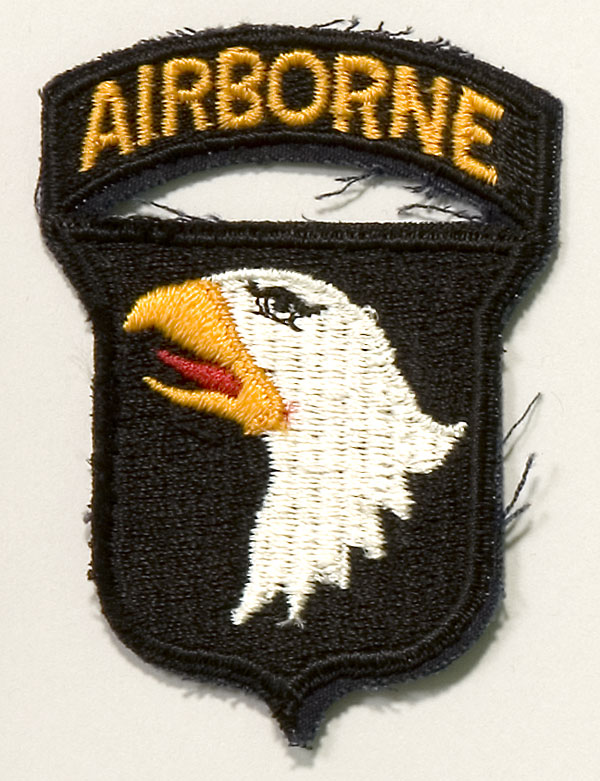Military Patch
1942-1945
Shoulder Patch of 101st. US Airborne Division
Nicknamed “The Screaming Eagles” because their shoulder patch emblem depicted an American Bald Eagle, the 101st Airborne Division was an elite unit made up of both paratroopers and glider men. On D-Day the unit had drop zones assigned to it on the Cotentin Peninsula, behind the German defenses that threatened the amphibious landings at Utah Beach. The 101st Division’s main objective was to secure the exit causeways leading off Utah Beach by attacking the German defenders from the rear.
Shortly after midnight on June 6, 1944, German anti-aircraft fire scattered the C-47 transport planes carrying both the 101st and 82nd Airborne Divisions. The jump into Normandy did not go as planned. Despite the missed drop zones, the paratroopers got together in small groups and set out to accomplish their missions. The fact that they were dispersed over such a broad area confused the Germans as well, working to the Allies’ advantage.
On the morning of D-Day, paratroopers from Easy Company of the 101st Division’s 506th Regiment, led by First Lieutenant Richard Winters, destroyed a battery of German guns that were opposing the 4th Division’s landings on Utah Beach. The battery’s location was not known prior to the invasion. The Americans also captured a detailed map showing all the other enemy defense positions in Normandy. For leading this attack Richard Winters received a Distinguished Service Cross. By the war’s end Major Winters commanded the 2nd Battalion of the 506th which included Easy Company.
The 101st Airborne Division faced its greatest test in the wintry Ardennes Forest in Belgium in the Battle of the Bulge. For one entire week it was surrounded while defending the crossroads town of Bastogne. On December 22, 1944, German General Heinrich von Luettwitz demanded its surrender. General Anthony MacAuliffe gave his now famous defiant reply… “To the German Commander: Nuts! The American Commander.”
Patton’s Third Army linked up with the 101st Airborne Division the day after Christmas. In January 1945 the 101st went back on the offensive. The division, with the help of armored units, recaptured the town of Houffalize northeast of Bastogne. By January 15 the Battle of the Bulge was essentially over and the soldiers of the 101st Airborne, by their bravery and endurance, had helped turn it into a victory instead of a defeat.
Cloth. H 9.0, W 6.4 cm
Eisenhower National Historic Site, EISE 9554.



